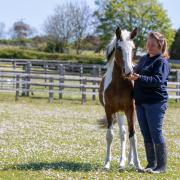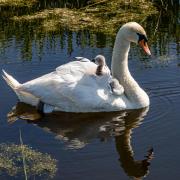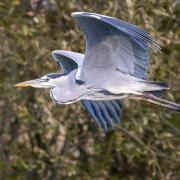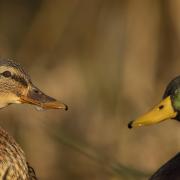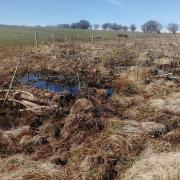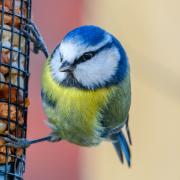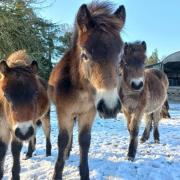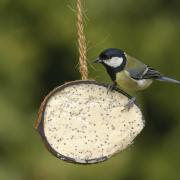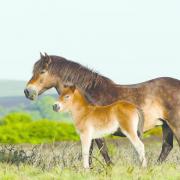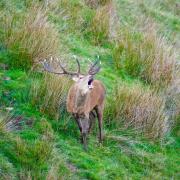The RSPB's Matt Brierley implores all visitors to Bath, and the city's residents for that matter, to pay special attention to one of the city's unnoticed but most regal of predators.
The RSPB’s Matt Brierley implores all visitors to Bath, and the city’s residents for that matter, to pay special attention to one of the city’s unnoticed but most regal of predators. Photos Mark Fisher.
It was there when I finished the half marathon, glowering at me as I lay on the pavement in pain. It was there as my fast train from London to Bristol rumbled past in summer sunshine; there when I strolled down the river with a pocket full of blackberries and only my shadow for company, in low autumnal light. When it snowed, it watched as I warmed up with a hot chocolate from the Christmas markets, bundles of gifts in my arms.
I want to stop commuters as they pour out of the railway station past the Georgian terraces. I want to cry out to them to glance upwards. I want to point at the spire of St John’s and holler “You’re missing it, it’s there now, and it can dive at 242 miles an hour!”
Above the streets of Bath, where faith punctuates the skyline, an apex predator scans the heavens. I’m really excited about it. Metaphorically, I want to join it on the rooftops and then shout about it.
You see, when I was little, in the 1980s, you couldn’t glimpse up from your nine to five and see a peregrine falcon. A peregrine was, for me, a pilgrimage. I lived in Manchester; our nearest peregrines were an adventure away, on a lonely windswept granite crag where the invariable Lancastrian dampness gave the nodding cotton grass a glossy sheen. I remember it all so vividly; my duffle coat, squinting down the RSPB scope, feeling pressured to see the bird so as not to disappoint my enthusiastic granny.
Pretending to see it, leaving, confessing, returning, really seeing it. Thirty years later, those first glimpses are still indelibly etched in my mind, and the euphoric excitement doesn’t seem to have ebbed; it has intensified. It was, inarguably, a pivotal moment. A spark that ignited something. From then on my childhood mind became an encyclopaedic collection of accumulated peregrine factoids.
Accumulation, as it turns out, is a topical word for birds of prey, with 8 July 1967 their red letter day. ‘Decrease in Eggshell Weight in Certain Birds of Prey’ may not sound like the snappiest title, but in that article a chap called Ratcliffe pieced it all together; organic pesticides accumulating in the food chain, top predators getting the biggest dose, eggshells thinning, eggshells breaking.
The moustached falcon sits on the edge of his Hawk and Owl Trust nest box, in his stripy grey and white trousers, unaware his species took a global stoop towards extinction. He’s back now, and in Bath he’s embracing city living in a life so peppered with controversy, that if birdwatchers wrote gossip mags he’d be splashed all over the front cover. The British Trust for Ornithology exposed his incestuous lifestyle. ‘Son boots dad out of nest to shack up with mum!’ was plastered all over the birding forums, the ‘peregrines pair for life’ fact debunked, along with the conventional wisdom that nature avoids inbreeding.
Next came the surprise dissection of his celebrity eating plan, all his gory dietary details picked apart in public. We’d be approving of feral pigeon. But woodcock? Water rail? Little grebe? And with these three all nocturnal migrants, the Bath peregrines brought hunting by streetlight to the UK. Can we extend this behaviour to the trendy set RSPB celebrate outside London’s Tate Modern? Are the peregrine urbanites in Taunton, Chichester, Worcester, Bournemouth and Manchester night owls too?
Up and down Britain peregrines are rubbing shoulders with people. So, the countryside must be full, right? Wrong. The reason peregrines are in cities is that peregrines are good at living there.
It’s all in the vision. Being hawk-eyed isn’t just about starting a hunt from a mile away, with visual acuity four times that of ours, and a retina twice the thickness. It’s not just about a peregrine’s fighter pilot goggles, a third eyelid called the nictitating membrane that keeps out dust on a dive. The real wow factor – and here is my favourite falcon factoid of them all – is that a peregrine’s eye processes light about four times more quickly than ours. So, it sees things four times more slowly. If you’re going to top a G-Force of 25 as you pull out of a dive (an F-16 fighter pilot experiences nine), it’s pretty handy if you can perceive the world around you as moving at a different speed. What I really like about this fact, though – and I think you’ll like it too – is that it means peregrines can fly in between raindrops!
So, what we perceive as a city’s hustle and bustle, to a peregrine, that’s easy street. And pigeons are fast food. Sort of. Yes, peregrines are back from the brink; the fastest animal on the planet, coming soon to suburbia near you.





